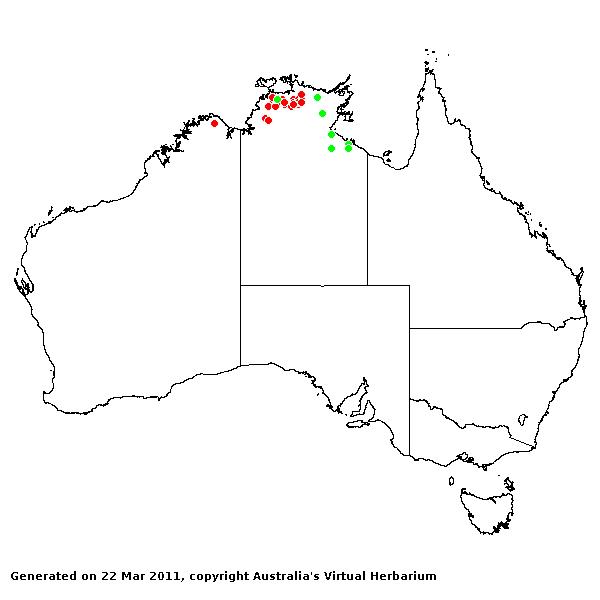Hygrochloa Brunonia 2: 86 (1979).
Derivation:. From the Greek hygros (wet, moist) and chloa (a grass), referring to habitat.
Taxonomic revisions, nomenclatural references:. M.Lazarides, Brunonia 2: 85–90 (1979).
Key references (keys and floras):. R.D.Webster, Australian Paniceae 97–99 (1987); B.K.Simon, Key to Australian Grasses 125 (1993); D.Sharp and B.K.Simon, AusGrass (2002).
W.D.Clayton & S.A.Renvoize, Genera Graminum (1986), genus (511).
Native, endemic. 2 species. NT.
Habit. Annual or perennial (aquatic to hydrophytic), tufted (H. cravenii, erect, not submerged, to 1 m high) or decumbent (H. aquatica, floating from submerged tufts). Leaf blades narrow. Ligule a fringe of hairs. Plants monoecious with all fertile spikelets unisexual.
Inflorescence. Inflorescence of spicate main branches. Spikelet-bearing axes with heteromorphic spikelets.
Spikelets. Spikelets all partially embedded in rachis (to some extent), dorsally compressed, 2 flowered, with 1 fertile floret, solitary; with rachilla terminating in a floret; sessile spikelet with lower incomplete floret. Fertile spikelets oblong or elliptic or obovate, abaxial (with lower glume on side away from rachis), dorsally compressed, falling with glumes.
Glumes. Glumes unequal, shorter than adjacent lemmas or long relative to adjacent lemmas, hairless, blunt, awnless, non-keeled, dissimilar (both membranous, the upper mauch larger and more substantial). Lower glume 0–3 nerved. Upper glume 5–7 nerved.
Florets. Lower incomplete floret(s) sterile. Lemmas awnless, 5–7 nerved, more or less equalling fertile lemmas, less firm than fertile lemmas (membranous), not becoming indurated. Fertile florets 1. Lemmas decidedly firmer than glumes (leathery to crustaceous), striate (or striolate), becoming indurated, yellow in fruit or brown in fruit, entire at apex, pointed, muticous (apiculate), with a clear germination flap, 5 nerved, having flat margins not tucked into palea, not keeled. Palea relatively long, entire, textured like lemma, 1 nerved, 2 keeled. Lodicules 2. Stamens 0. Stigmas 2. Grain small (1.5–1.75 mm long), compressed dorsiventrally. Hilum short. Embryo large.
Kranz Anatomy. C4.
Habitat. Hydrophytic to helophytic.
Classification. Panicoideae; Paniceae.
Notes. The genus is very similar to Paspalidium, despite the Digitaria-like upper lemma. The leaf-blades are densely papillose above, the trapped air presumably assisting flotation (Clayton and Renvoize, 1986).
Types Species. H. aquatica Lazarides.
Biogeographic Element. Clifford & Simon 1981, Simon & Jacobs 1990: Endemic.


